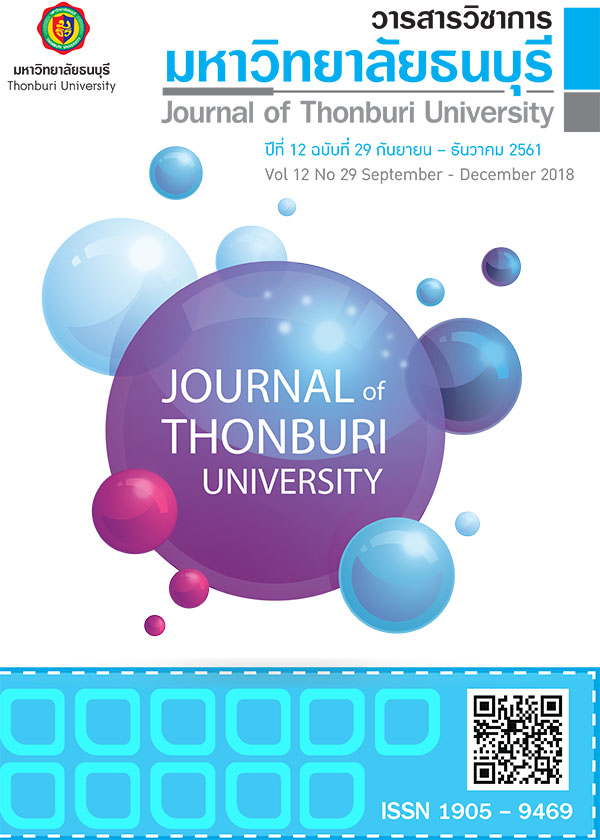TALENTED AND VIRTUOUS PEOPLE: THE DRIVING ORGANIZATION TOWARDS HIGH-PERFORMANCE ORGANIZATION
Keywords:
Talent People, Virtuous People, High-Performance OranizationAbstract
Abstract
This research aimed to study ways to manage virtuous and talented people in the organization to result in a high-performance organization and to bring the knowledge to be applied in the development of high-performance organization comparing between multinational and Thai companies. The study was quantitative research and the samples used in the study consisted of 365 financial companies to obtain descriptive statistics values. Inferential statistics (SEM) were used for the quantitative research. The findings are as follows: 1) the important elements of virtue person include being ethical, honest, optimistic (positive attitude) and generous with colleagues. 2) Elements of a talent person include being outstanding in many areas, prominent and clever at work. 3) Training, learning from experiences, and education are considered important factors to create talent people also result in the high-performance organization. 4) There are the differences between multinational and Thai organization in term of virtue and talent people to high performance organization.
Keywords: Talent People, Virtuous People, High-Performance Oranization
References
Bandler, R & Grinder, J. (1979). Frogs into Princes: Neuro Linguistic Programming. London.
Bandler, R. (1985). Using your Brain for a Change. Real People Press, Moab, CO. pp. 37-67.
Barlett, C & Ghosgal, S. (2003). Managing across borders. The British Journal of Administrative Management, 24.
Bryk, AS & Raudenbush, SW. (1989). Methodology for cross-level organizational research. Research in Sociology of Organizations. 7: 233-273.
Buytendijk, F. (2006). Five keys to building high performance organization. Available from http://businessfinance mag.com/business-performance-management/five-keys-building-high-performance-organization
Chonnutchakangwansupapun. (2014) Human Capital – the acceleration factor of international entrepreneur. Business Administration journal. 37(142): 3-13.
Cronbach, L. J. (1951). Coefficient alpha and the internal structure of tests. Psychometrika. 16(3): 297–334.
De Waal, A. (2007). The characteristics of a high performance organization. Business strategy series. 8(3): 179-185.
Hair, JF, Hult, GTM, Ringle, CM & Sarstedt, M. (2014). A Primer on Partial Least Squares Structural Equation Modeling. Sage: Thousand Oaks, CA.
Hofstede, G. (1980). Culture’s Consequences. Sage, Beverly Hills, CA.
Hofstede, G. (1998). Cultures and Organizations. Harper Collins Business, London.
Hu, LT & Bentler, PM. (1999). Cutoff criteria for fit indexes in covariance structure analysis: conventional versus new alternatives’, Structural Equation Modeling 6(1): 1-55.
Huselid, M, Beaker, B & Beatty, R. (2005). Managing employees, careers allows for strategy execution Canadian HR Reporter. June (22).
Jarinto, K. (2011). Understanding stress in multinational companies in Thailand. International Business Research. October 2011: 153-163.
Kohlberg, L. (1973). The Claim to Moral Adequacy of a Highest Stage of Moral Judgment. Journal of Philosophy. 70(18): 630–646. doi:10.2307/2025030.
Lance A. B & Martin J. S. (1994). The change management handbook: A road map to corporate transformation. Irvin professional publishing.
Lei, M & Lomax, RG. (2005). The effect of varying degrees of nonnormality in structuralequation modeling. Structural Equation Modeling. 12(1): 1-27.
Mattanachai, S. (2013). The exit of Thai Business to the way of sustainability development. Journal of Business Administration. 36(137): 38-48.
Noe, RA, Hollenbeck, JR, Gerhart, B, & Wright, PM. (2012). Human Resource Management: Gaining a Competitive Advantage. 8thed. McGraw-Hill.
Office of the Public Sector Development Commission Thailand [OPDC]. (2008). Annual Report part 2. Available from http://www.opdc.go.th/uploads/files/Report/report2551/Annual_Report_Part2_2.pdf
Piyachat, T. (2014). Talent Management, June 3, 2014, Available from https://www.gotoknow.org/posts/115875
Pornrat, S. (2015). Talent Engagement. Productivity World journal. 80-81.
Schermerhorn, JR. (2015). Introduction to management. 13thed. Hoboken, NJ: Wiley & Son.
Thorne, K & Pellant, A. (2007). The essential guide to managing talent: How top companies recruit, Train and retain the best employees. London: Kogan Page.
Turner, RC & Carlson, L. (2003). Indexes of item-objective congruence for multidimensional items. International Journal of Testing. 3(2): 163–171.







